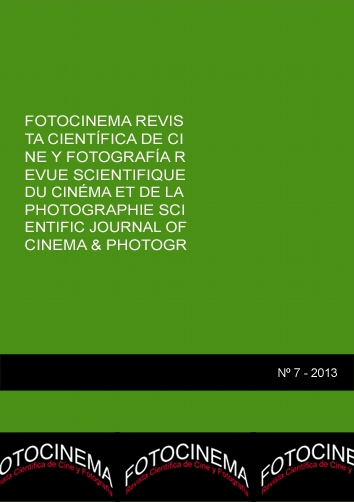Tiempo, memoria, imagen: Sans soleil de Chris Marker
DOI:
https://doi.org/10.24310/Fotocinema.2013.v0i7.5932Abstract
<!-- /* Font Definitions */ @font-face {font-family:"Cambria Math"; panose-1:2 4 5 3 5 4 6 3 2 4; mso-font-charset:0; mso-generic-font-family:auto; mso-font-pitch:variable; mso-font-signature:3 0 0 0 1 0;} @font-face {font-family:"MS Mincho"; mso-font-alt:"?? ??"; mso-font-charset:128; mso-generic-font-family:modern; mso-font-pitch:fixed; mso-font-signature:-536870145 1791491579 18 0 131231 0;} /* Style Definitions */ p.MsoNormal, li.MsoNormal, div.MsoNormal {mso-style-unhide:no; mso-style-qformat:yes; mso-style-parent:""; margin:0cm; margin-bottom:.0001pt; mso-pagination:widow-orphan; font-size:12.0pt; font-family:"Times New Roman"; mso-fareast-font-family:"MS Mincho"; mso-fareast-language:JA;} .MsoChpDefault {mso-style-type:export-only; mso-default-props:yes; font-size:10.0pt; mso-ansi-font-size:10.0pt; mso-bidi-font-size:10.0pt; mso-fareast-font-family:"MS Mincho";} @page WordSection1 {size:612.0pt 792.0pt; margin:70.85pt 3.0cm 70.85pt 3.0cm; mso-header-margin:36.0pt; mso-footer-margin:36.0pt; mso-paper-source:0;} div.WordSection1 {page:WordSection1;} -->Considerado uno de los ejemplos más representativos del ensayo fílmico, el cine de Chris Marker se ha caracterizado hasta la reciente fecha de su muerte por una insistente interrogación sobre el poder y la función de la Imagen. En este sentido, el filme Sans soleil (1982) supone una referencia ineludible al establecer un punto de acceso a una nueva etapa de su dilatada carrera donde el interés por las imágenes del presente se iría sustituyendo por una obsesión por las imágenes del pasado, ya sean aquellas que han servido para escribir la Historia, ya sean aquellas de carácter más íntimo que se arremolinan caóticamente en las memorias individuales. Unas y otras imágenes componen Sans soleil, imágenes acumuladas por un coleccionista consciente de la especial melancolía que las impregna, y que pasan a constituirse en escritura fílmica. Es precisamente esta escritura el objeto de estudio del presente artículo, más concretamente, la manera en la que ésta desarrolla un característico discurso sobre el tiempo, la imagen y la memoria que se demostrará decisivo en la posterior filmografía markeriana.
Chris Marker’s films, which are considered to be some of the most representative examples of film-essay, have been marked until his recent death by a persistent questioning over the power and the purpose of Image. His film Sunless (1982) is at that respect an unavoidable reference when establishing a first step into a new phase within his long career. A phase where he slowly dropped interest for images of the present and developed instead an obsession for images from the past. The obsession comprised those images used to write History, as well as the more intimate ones that belong to the chaotic flow of individual memories. Sunless is made out of both kinds of images. Images accumulated by a collector who is aware of the special melancholy they are steeped in. Images that become film writing themselves. This article explores this writing, and more specifically, its characteristic discourse about time, image and memory, which will prove to be decisive along the following markerian filmography.
Downloads
Metrics
Downloads
Published
How to Cite
Issue
Section
License
All contents published in Fotocinema Revista científica de cine y fotografía are protected under the Creative Commons Attribution-NonCommercial-ShareAlike 4.0 International (CC BY-NC-SA 4.0) license. All about this license is available in the following link: <http://creativecommons.org/licenses/by-nc-sa/4.0>
Users can copy, use, redistribute, share and exhibit publicly as long as:
- The original source and authorship of the material are cited (Journal, Publisher and URL of the work).
- It is not used for comercial purposes.
- The existence of the license and its especifications are mentioned.
There are two sets of authors’ rights: moral and property rights. Moral rights are perpetual prerogatives, unrenounceable, not-transferable, unalienable, imprescriptible and inembargable. According to authors’ rights legislation, Fotocinema. Revista científica de cine y fotografía recognizes and respects authors moral rights, as well as the ownership of property rights, which will be transferred to University of Malaga in open access. The property rights are referred to the benefits that are gained by the use or the dissemination of works. Fotocinema. Revista científica de cine y fotografía is published in an open access form and it is exclusively licenced by any means for doing or authorising distribution, dissemination, reproduction, , adaptation, translation or arrangement of works.
Authors are responsable for obtaining the necessary permission to use copyrighted images.













13.png)




